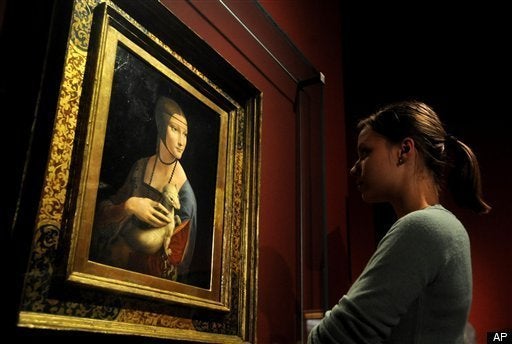
We're more than proud to say that Levenger Press has just published a new work by bestselling author Ross King, The Fantasia of Leonardo da Vinci: His riddles, jests, fables and bestiary. I know many readers are fans of Ross, as am I -- I loved both his Michelangelo and the Pope's Ceiling and Brunelleschi's Dome.
In The Fantasia, Ross introduces us not to the artist Leonardo but to the writer and reader. And he shows us Leonardo off camera -- the view that only scholars like Ross have really known, until now. Here's some of our recent conversation with Ross about the genius who called himself "an unlettered man" and had a huge distrust of "infinite children."
Levenger Press: How did Leonardo combine what was on the page with what was happening in the streets around him for his writing?
Ross King: Leonardo was a great observer of the world around him. We're told he always kept tucked in his belt a little notebook in which he jotted down anything that amused or interested him. He also used to follow people through the streets of Florence or Milan, surreptitiously making sketches of their features with a view to using them in paintings. And, of course, he made meticulous drawings of the bodies he dissected, as well as of the machines he planned to build. That said, Leonardo also valued what he found in books.
LP: Is there any connection between what he drew and what he read?
Ross: What is probably Leonardo's most famous drawing -- the nude man with his arms and legs outspread -- was based on the writings of the Roman architect Vitruvius.
LP: Would the books in Leonardo's library have been illustrated?
Ross: Leonardo himself worked as a book illustrator, since he did the illustrations for his friend Luca Pacioli's Divine Proportion, which was published in 1509. Hand-illuminated books or manuscripts, however, would have been far too expensive for Leonardo. Only wealthy families, such as the Medici, could afford them. But a number of his books would have been illustrated with woodcuts. Woodcut illustration was a fairly new technology, but in the fifteenth century Florence was a center for it. One of the books he owned, Luigi Pulci's Morgante Maggiore, had woodcut illustrations. Also, most editions of Aesop printed after 1480 - and Leonardo owned one of those as well - included charming woodcuts.
LP: Did Leonardo mean for his own fables and bestiary to be published?
Ross: I'm sure he did. He clearly had plans to print and publish numerous books of his own, both scientific treatises and more diverting books such as his bestiary. He was an inveterate writer. We now have almost 6,000 pages of his notes and drawings -- and this is less than half of the papers he wrote in his lifetime. Unfortunately, Leonardo seldom finished things he started, and he never saw any of his works through the printing press.
LP: What was a bestiary, and why were they a popular form of allegory?
Ross: A bestiary is a "book of beasts," a collection of stories giving allegorical descriptions of animal behavior. Bestiaries were popular because they were treasure troves of animal lore, and they were often highly amusing to read. They were also popular because they could be used as vehicles for moral and religious teaching. Furthermore, they were used to teach children to read. Leonardo owned a bestiary called the Fior di Virtù ("Flower of Virtue"). This may have been one of the first books he ever learned to read.
Ross: Leonardo was one of history's great animal lovers. He was said by one of his earliest biographers, Giorgio Vasari, to love the whole of the animal kingdom, and to treat all living creatures "with wonderful love and patience" -- a very rare thing in the fifteenth and sixteenth centuries! Vasari describes how Leonardo used to buy caged birds and release them into the air. He was also, for at least part of his life, a vegetarian, refusing to eat anything that contained blood.
LP: Do we know how Leonardo physically read? Did he try to read his books in the mirror way that he wrote?
Ross: I think it's unlikely in the extreme that he read books by means of a mirror. His major problem in reading books was his lack of expertise in Latin. He famously called himself an uomo senza lettere - an "unlettered man." By that I think he meant that he was a disciple of experience, not books - which is not strictly true. But he didn't have the qualification that all "lettered" men had: a good knowledge of Latin. He may have studied some Latin as a child, since his father was a notary, but he didn't really begin studying Latin seriously until he was in his late 30s. He probably never really achieved a great proficiency.
LP: How do you think he would feel about e-books? Would the animal-rights/vegan in him applaud the absence of vellum?
Ross: I suspect that Leonardo, who loved invention, would have embraced technology such as e-books, especially if it meant saving the lives of animals. Many books in Leonardo's day were made from vellum--the skins of calves, lambs and kids. He deplored the slaughter of these creatures and believed, unlike virtually all of his contemporaries, that animals had souls.
LP: As a man of invention, he must have applauded the printing press.
Ross: Strangely, Leonardo was suspicious of printed books and the printing press. He distrusted a process, such as printing, that produced what he called "infinite children" without differentiation between original and copy. I suspect he would have preferred his works to appear in manuscript form rather than by means of moveable type.
LP: What would have been the inspiration for his riddles?
Ross: Riddles were a popular form of amusement at European royal courts, where poets and jesters matched wits against one another for the amusement of kings and courtiers. Leonardo was part of this long tradition, since he used to divert and amuse the courtiers in Milan with riddles and stories. The inspiration for these riddles came from the world around him - and, very often, from his disgust at its senselessness and violence. Many of his riddles cast a light on man's cruelty to man, and especially to animals.
LP: Would any of his friends have been able to guess the answers?
Ross: Some of them, certainly. One of his friends and fellow riddlers was the great architect Donato Bramante. Another friend was the mathematician Luca Pacioli. It's hard to imagine even Leonardo stumping such brilliant minds.
LP: What's your favorite Leonardo riddle?
Ross: "Men will walk and not stir, they will talk to those who are not present, and hear those who do not speak."
LP: Should we tell our readers the answer?
Ross: I wouldn't dream of withholding it.
